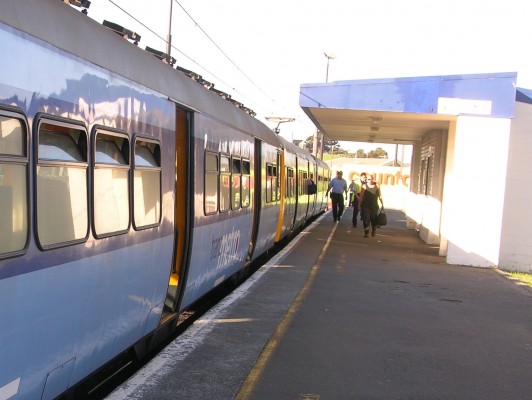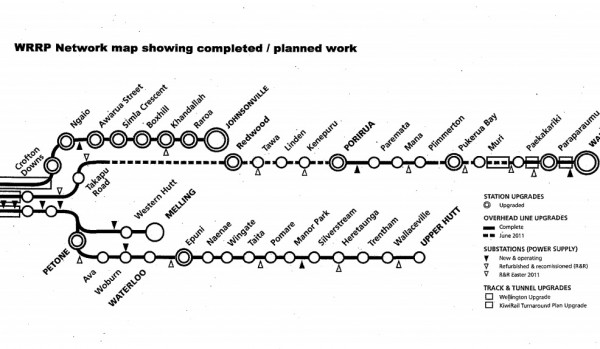Real State Of Wgtn Rail
A Treasury briefing paper reveals the sad state of Wellington’s commuter rail network - despite the arrival of the new Matangi trains. It will take 8 more years of work.
It reveals that “KiwiRail has advised (Treasury) that additional work is required to provide for the safe and reliable operation of the Wellington metro network.”
It says :”The Wellington metro rail network is substantially more robust than pre WRRP, but in certain areas WRRP intentionally left works that were not essential for the operation of the Matangi trains, but are desirable to achieve network integrity. ”
The paper lists what needs to happen:
For the existing network to provide reliable service for Wellingtonians, there are a number of further issues that need to be progressed.
These include:
- The refurbishment of the Ganz Mavag units, at an estimated cost of $80 million. The Ganz Mavags, which were built in Hungary 29 years ago, are at the end of their operational life. They need refurbishment so they can meet current and future peak period.
- Completing the renewal of the rail network infrastructure. it is proposed to undertake the following capital upgrades of the Wellington rail network infrastructure over eight years:
- Renewal of the remainder of the traction (overhead power) system at a cost of $56 million
- Renewal of the signalling system at a cost of $23 million
- Renewal of old platforms at a cost of $9 million.
- Payment of reasonable track access costs to Kiwi Rail to meet the costs of maintaining the network infrastructure, so that the network no longer declines over time. This is estimated to cost an additional $7.3 million a year.
 The Budget package saw the regional council GWRC would accept full responsibility for operating the metro rail services, with funding support from NZTA. GWRC’s responsibilities would include the following:
The Budget package saw the regional council GWRC would accept full responsibility for operating the metro rail services, with funding support from NZTA. GWRC’s responsibilities would include the following:
- defining the level of service, and meeting associated costs, with support from NZTA.
- paying fair and negotiated track access charges from 2011/12. This would increase from the current $7.9 million to $15.2 million in 2011/12, increasing to $15.8 million by 2013/14. The increased track access charges would meet the costs of maintenance and the regular renewal of track, signals and traction so that the network no longer declines over time.
- being the major shareholder in a Rolling Stock Ownership Company which owns rolling stock (the Matangi and Ganz Mavag units), accepting responsibility for maintaining them, and financing the estimated $80 million refurbishment of the Ganz Mavag units.
- meeting the $22.7 million shortfall from the Crown’s $258 million Budget 2009 appropriation that was outlined as a budget risk in the Vote Transport 4 Year Budget Plan, in return for the ownership of the new electric multiple unit depot.
- taking responsibility for maintaining and developing all above-ground facilities on the network, including stations (excluding Wellington station), car parks and over-bridges.
GWRC will borrow to meet the costs of the Ganz Mavag upgrade and for the $22 million shortfall, with principal and interest payments estimated at $2.9 million a year. GWRC will have to raise rates to meet their side of the package, and they intend to include financial provision for the package in their draft Annual Plan. (as has happened since).
How the relationship works between the bodies is also spelt out.
KiwiRail will continue to provide, maintain and renew the rail network infrastructure and provide network services (traction, signalling, train control etc). The broad direction of the package has been discussed by the Kiwi Rail Board.
KiwiRail, through TranzMetro, will continue as train operator for metro passenger services, and the existing 1 0-year contract will be reviewed in mid-2011 to be more performance-based and provide incentives for TranzMetro to perform.
KiwiRail will accept the transfer of the Ganz Mavags and above ground assets (except Wellington Station) at a price which reflects their current actual nominal value.
NZTA would provide additional funding support to meet the shortfall in operational funding for the metro rail service.
The Crown will retain ownership of the Wellington metro rail network infrastructure (ie track, signals, power supply etc) and be responsible for future investment to bring the network to a functional, safe and reliable standard.
In terms of the proposed package, the Crown would invest $88.4 million over eight years to complete the upgrade of the rest of the traction, signalling and platform assets. This investment would get the network up to a functional, safe and reliable standard and enable GWRC to meet the network’s ongoing costs through the increasing track access charges.
The paper gives an insight into Government thinking on commuter rail.
The benefits to the Crown are listed as being:
- the acceptance by GWRC, with assistance from NZTA, of the liability for the future operation, maintenance and renewal of the rolling stock, stations and other assets, and payment for regular renewal of the infrastructure through increased track access charges.
- no requirement by the Crown to fund the Ganz Mavag unit refurbishment ($80 million), presently owned by KiwiRail, beyond funding the NZTA share through the NLTF.
- fair track access charges for use of the rail network. GWRC will pay significantly more in track access charges to cover the costs of operating, maintaining and regular renewals of the metro rail network. This avoids Kiwi Rail subsidising the network, with an impact on its commercial performance. it removes the risk of running down the metro network through deferred maintenance and renewals.
- no commitments for further upgrades of the network beyond the proposed traction, signalling and platform renewals. The requirement for GWRC to take clear responsibility for costs will ensure any future development proposals involve realistic plans for matching revenues with costs.
- Kiwi Rail Group, as a state owned enterprise, is able to concentrate on putting its core freight business on a much more commercial basis.












11 Comments
It would be interesting to know just how long Auckland is expected to take to get a fully reliable service. My understanding is that we are getting a pretty much completely overhauled and repaired network as part of electrification but there are bound to be other things needed that have been left out at this stage.
In that regards I think we are a little ahead of Wellington but that is only because we have had to do more to get the network up to an acceptable standard. With electrificaion finished in 2013 it would have been 10 years since rail improvements started with the opening of Britomart.
I really really, hope they mean spending up to 8 years improving the network that is similar, to Transperth standards…..
If anybody needs a reason not to vote for asset sales (Read National) this would be one of them, Auckland a 2nd.
The Privatizing of rail has turned out to be a total farce.
Stip out the assets and then sell it back to the government as with AIr NZ, Bank of NZ andf others.
How can local bodies own trains? It’s a disgrace. Oh, wait - Wellington. Different rules than Auckland.
@John Dalley - Meh, wait 5 minutes and you will find the arguing that with all those asset sales, we can spend the money on improving public transport!
Then see the money being used for motorways.
Yeez, I am cynical today. But good to hear Wellington has plan to move forward and keep upgrading. Despite the rankles about different treatment, it’s good stuff.
The requirement for GWRC to take clear responsibility for costs will ensure any future development proposals involve realistic plans for matching revenues with costs.
No capital expenditure then.
…unless GWRC levy the spending through rates, of course.
I read all the PT and related news regarding reasons and excuses with dismay, the years have rolled on and complexities of owned by them, leased back to that group, managed by those few there, paid subsidies by the masses. Is there anywhere else in the world that PT is so over contolled and confusing? When PT reverts back to a simple frame umbarella I’m sure the cars will finally stay in the garages.
Who oversaw the planning and maintenance of the Wellington network over at least the last 10 years?
How was the bleeding obvious ignored that is that the EMU’s currently in service would need replacement and why was it left so late to replace them, much less the track and overhead networks?
My guess is this is the real reason the government had to buy back NZ Rail was because private enterprise had stuffed the system so badly it was at the point of abandonment.
@Kurt, It wasn’t overly flash under NZ Rail either.
Wellington’s rail investment has always come in big bumps, and then gets forgotten until it wears out.
Hence why a fairly large number of the traction poles being replaced on the Kapiti line are from the 1940/50s
Greenwelly, it may be a deplorable fact, but that kind of stuff is a deplorable fact almost worldwide.
Even in roading, the tendency is to build lots of roads, then let them rot, until you have to do them over. The problem is that it is so much sexier for politicans and designers to think up new schemes than maintain the old.
Well said Karl. You are right on the nail. Lack of investment in meto rail had little if nothing to do with privitisation. Most countries have had similar problems with infrastructure in the boom / bust nature of investment and asset planning / management is a relatively new idea that relates to a more sustainable asset plan. The problem goes back many decades and most informed commentators now recognize this fact and don’t harp on about privatization as the cause - more a symptom. Rail investment can and does happen under private and public sector ownership models. People either have short memories or think Rail was in some sort of nirvana pre privitisation - it most certainly wasn’t! It has been in the dog house for decades in this country.
Time for people to get over the anti privatization mindless rants they have and look at the real causes of under investment over decades in Rail. It has always been political will.